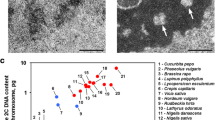Summary
Giemsa techniques have refused to reveal G-banding patterns in plant chromosomes. Whatever has been differentially stained so far in plant chromosomes by various techniques represents constitutive heterochromatin (redefined in this paper). Patterns of this type must not be confused with the G-banding patterns of higher vertebrates which reveal an additional chromosome segmentation beyond that due to constitutive heterochromatin. The absence of G-bands in plants is explained as follows: 1) Plant chromosomes in metaphase contain much more DNA than G-banding vertebrate chromosomes of comparable length. At such a high degree of contraction vertebrate chromosomes too would not show G-bands, simply for optical reasons. 2) The striking correspondence of pachytene chromomeres and mitotic G-bands in higher vertebrates suggests that pachytene chromomeres are G-band equivalents, and that this may also be the case in plants. G-banded vertebrate chromosomes are on the average only 2.3 times shorter in mitosis than in pachytene; the chromomeric pattern therefore still can be shown. In contrast, plant chromosomes are approximately 10 times shorter at mitotic metaphase; their pachytene-like arrangement of chromomeres is therefore no longer demonstrable.
Similar content being viewed by others
Literature
Afzal-Rafii, Z.: Recherches sur le genre Salvia en région méditerranéenne & au Proche-Orient. Thèse. Marseille 1975
Bennett, M.D.; Smith, J.B.: Nuclear DNA amounts in angiosperms. Phil. Trans. Roy. Soc. (Lond.) B 274, 228–274 (1976)
Ernst, H.: Zytogenetische Untersuchungen an Antirrhinum majus L. Z. Bot. 34, 81–111 (1939)
Ernst, H.: Zytogenetische Untersuchungen an haploiden Pflanzen von Antirrhinum majus L. I. Die Meiosis. Z. Bot. 35, 161–190 (1940)
Greilhuber, J.: Heterogeneity of heterochromatin in plants: Comparison of Hy- and C-bands in Vicia faba. Plant Syst. Evol. 124, 139–156 (1975)
Heitz, E.: Die Herkunft der Chromocentren. Planta 18, 571–636 (1932)
Heneen, W.K.: Chromosome morphology in inbred rye. Hereditas 48, 182–200 (1962)
Lima-de-Faria, A.: Chromomere analysis of the chromosome complement of rye. Chromosoma 5, 1–68 (1952)
Lima-de-Faria, A.: Chromosome gradient and chromosome field in Agapanthus. Chromosoma 6, 330–370 (1954)
Lima-de-Faria, A.: The relation between chromomeres, replicons, operons, transcription units, genes, viruses and palindromes. Hereditas 81, 249–284 (1975)
Lima-de-Faria, A.; Sarvella, P.; Morris, R.: Different chromomere numbers at meiosis and mitosis in Ornithogalum. Hereditas 45, 467–480 (1959)
Lima-de-Faria, A.; Sarvella, P.: Variation of the chromosome phenotype in Zea, Solanum and Salvia. Chromosoma 13, 300–314 (1962)
Lima-de-Faria, A.; Daskaloff, S.; Enell, A.: Amplification of ribosomal DNA in Achaeta. I. The number of chromomeres involved in the amplification process. Hereditas 73, 99–118 (1973a)
Lima-de-Faria, A.; Gustafsson, T.; Jaworska, H.: Amplification of ribosomal DNA in Achaeta. II. The number of nucleotide pairs of the chromosomes and chromomeres involved in amplification. Hereditas 73, 119–142 (1973b)
Luciani, J.M.; Morazzani, M.-R.; Stahl, A.: Identification of pachytene bivalents in human male meiosis using G-banding technique. Chromosoma 52, 275–282 (1975)
Nagl, W.: Zellkern und Zellzyklen. Stuttgart: Verlag Eugen Ulmer 1976
Okada, T.A.; Comings, D.E.: Mechanisms of chromosome banding. III. Similarity between G-bands of mitotic chromosomes and chromomeres of meiotic chromosomes. Chromosoma 48, 65–71 (1974)
Schnedl, W.: Analysis of the human karyotype using a reassociation technique. Chromosoma 34, 448–454 (1971)
Schweizer, D.: Vergleichende Untersuchungen zur Längsdifferenzierung der Chromosomen von Vicia faba L. Verhandl. Naturf. Ges. Basel 83, 1–75 (1973)
Schweizer, D.: Reverse fluorescent chromosome banding with chromomycin and DAPI. Chromosoma 58, 307–324 (1976)
Sharma, A.K.; Mukhopadhyay, S.: Chromosome study in Agapanthus and the phylogeny of its species. Caryologia 16, 127–137 (1963)
Sumner, A.T.: Banding as a level of chromosome organization. In: Current Chromosome Research (eds. Jones, K.; Brandham, P.E.), pp. 17–22. Amsterdam: Elsevier/North-Holland Biomedical Press 1976
Webb, G.C.: Chromosome organisation in the Australian plague locust, Chortoicetes termini fera. 1. Banding relationships of the normal and super-numerary chromosomes. Chromosoma 55, 229–246 (1976)
Weimarck, A.: Heterochromatin polymorphism in the rye karyotype as detected by the Giemsa C- banding technique. Hereditas 79, 293–300 (1975)
Yunis, J.J.: High resolution of human chromosomes. Science 191, 1268–1270 (1976)
Author information
Authors and Affiliations
Additional information
Communicated by H.F. Linskens
Rights and permissions
About this article
Cite this article
Greilhuber, J. Why plant chromosomes do not show G-bands. Theoret. Appl. Genetics 50, 121–124 (1977). https://doi.org/10.1007/BF00276805
Received:
Issue Date:
DOI: https://doi.org/10.1007/BF00276805




